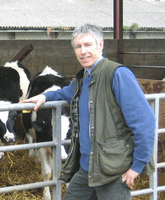Vet Watch: Cell count, TB, BVD and liver fluke
Matthew Berriman

Rosevean Vet Practice, Penzance.
In recent months we’ve been carrying out a number of investigations into rising bulk milk cell counts. In most cases bacteriology has shown environmental bacteria and particularly Strep. uberis to be the cause of these rising cell counts.
A major contributing factor in many of these is malfunctioning milking machines. New infections are also often picked up during the dry period. We have found dynamic milk machine testing is a must to pick up milking machine problems, while using a combination of teat sealant and antibiotic at drying off gives far better protection during the dry period.
We have also been involved in health planning visits on many of our farms. In beef herds we have been focusing on parasite control and have found that, with individual control programmes, many of our farms have been able to substantially reduce the amount of wormer they are using, yet still achieve excellent parasite control.
Paul Rodgers, Allen and Partners,

Millfield , Dyfed
During a recent visit to New Zealand I spent time with a District Disease Control Manager. His roles include managing and investigating TB outbreaks on farms, planning control of TB in possums and assisting the Animal Health Board to achieve TB-free status for NZ.
Their strategy has three, equally important legs:
- Removing infected cattle and deer by strict testing (single intra-dermal and blood).
- Controlling movement from infected herds.
- Controlling vector populations.
The more they spend on wildlife control (about £20m/year), the fewer infected farms. Less than 50% of this money comes from government. This approach seems to be working, NZ should be TB free by 2013.
The Welsh Assembly has developed a useful biosecurity tool and has allocated an extra £27m over three years for TB control. The time is ripe for us to adopt and adapt the three-legged approach to control TB in the UK.
Ruth Buxton,
Wensum Valley Vets, Fakenham, Norfolk
Bovine Viral Diarrhoea (BVD) rarely causes diarrhoea. It causes fertility problems – resulting in resorption and abortion – and hits the immune system resulting in pneumonia, gastro-intestinal and other problems.
It is arguably the single most important disease on beef farms in terms of lost profits. Poor fertility and poor conversion rates result in less beef produced. Beef farmers can check their herd’s BVD status by taking blood samples from five calves (nine months old or more) from each separately managed group. This will show whether they have an active BVD situation.
We have been doing this as part of the Norfolk and Suffolk BVD Eradication Scheme and have seen dramatic improvements where BVD has been eradicated on farms. All beef farmers should know their herd’s BVD status. If BVD were to be eradicated countrywide – as has already been done in Sweden and in the Orkneys – we would see fewer health problems and farmers would see more profit.
Donald McMillan,
The Minster Vet Practice, York
Traditionally in the York area, liver fluke has not been a significant problem, but changing weather patterns have resulted in more cases being diagnosed.
On farms where there is a known problem, dosing will have been carried out in autumn or winter and repeat dosing will not be needed until later in spring. Early fluke stages may be present on grass in March and infect grazing animals, but at low levels.
Fluke present in animals will be mainly adults and these will release eggs, so fluke egg counts should be done on at-risk farms. Fluke eggs passed in spring will develop over summer and lead to infective stages in autumn.
Remember, the signs of chronic liver fluke can be vague due to varying degrees of infection. Weight loss and poor body condition may be seen and in dairy cows there may be a reduction in milk yield and increased susceptibility to other infectious diseases.


